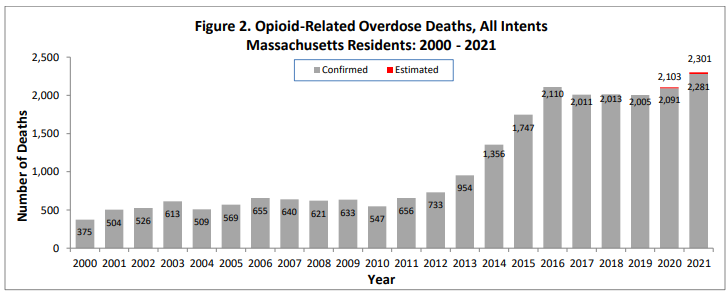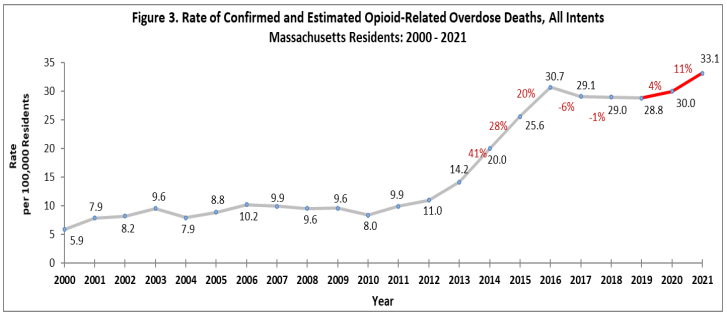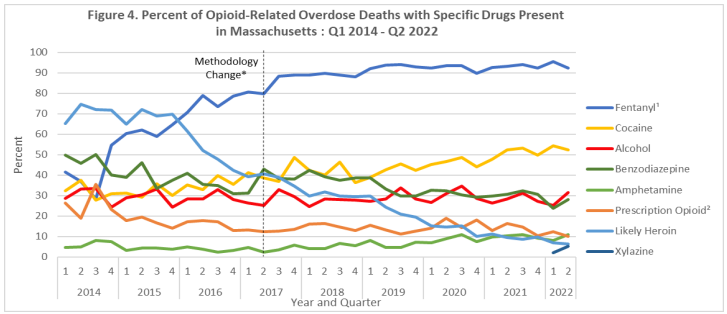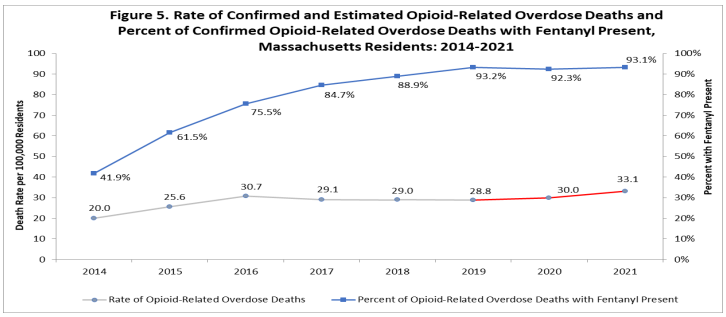Data Brief: Opioid-Related Overdose Deaths among Massachusetts Residents
Massachusetts Department of Public Health: This report contains both confirmed and estimated data through September 2022.

Figure 1 shows the month-by-month estimates for fatal opioid-related overdoses for all intents from July 2020
through September 2022. In the first nine months of 2022, there were 1,340 confirmed opioid-related overdose deaths
and DPH estimates that there will be an additional 41 to 70 deaths, yielding approximately 1,696 total confirmed and
estimated opioid-related overdose deaths. This is an estimated 25 fewer deaths compared to 1,721 total confirmed and
estimated opioid-related deaths in the first nine months of 2021, which is a decrease of 1.5%.

Figure 2 shows the trend in annual number of confirmed and estimated cases of opioid-related overdose deaths for all
intents from 2000 to 2021. In order to obtain timelier estimates of the total number of opioid-related overdose deaths
in Massachusetts – confirmed and estimated – DPH used predictive modeling techniques for all cases not yet finalized by
the Office of the Chief Medical Examiner (OCME). Based on the data available as of November 1,2022 there
were 2,281 confirmed opioid-related overdose deaths in 2021 and DPH estimates that there will be an additional 11 to
29 deaths once all cases are finalized.
Opioid-Related Overdose Death Rates, All Intents
The 2021 opioid-related overdose death rate (33.1 per 100,000 people) is approximately 8% higher than in 2016 (30.7
per 100,000 people), though this difference is not statistically significant. This indicates that the statewide opioid-related
overdose death rate has been stable for the period between 2016 and 2021. Joinpoint analysis indicated that there were
statistically significant overdose death rates from 2000 to 2012 (increasing by 3.2% per year) and from 2012 to 2016
(increasing by 31.5% per year).

Toxicology Analysis: Fentanyl and Other Drugs
Fentanyl is a synthetic opioid that has effects similar to heroin. It is administered in patients in fast-acting formulations
for severe, acute pain and prescribed to patients with chronic pain in long-acting formulations. According to the U.S.
Department of Justice, Drug Enforcement Administration’s 2015 Investigative Reporting, while pharmaceutical fentanyl
(from transdermal patches or lozenges) is diverted for abuse in the United States at small levels, much of the fentanyl in
Massachusetts is due to illicitly-produced fentanyl, not diverted pharmaceutical fentanyl.
The standard toxicology screen ordered by the Office of the Chief Medical Examiner includes a test for the presence of
fentanyl.
In 2021, there were 2,156 opioid-related overdose deaths where a toxicology screen was also available. Among these
deaths, on average fentanyl was present in 93%, cocaine in 52%, benzodiazepines in 31%, alcohol in 28%, prescription
opioids in 14%, and heroin in 10% and amphetamines in 10%.
In the first six months of 2022 there were 1,043 opioid-related overdose deaths where a toxicology screen was also
available. Among these deaths, fentanyl was present in 94%, cocaine in 53%, benzodiazepines in 26%, alcohol in 28%,
prescription opioids in 11%, heroin in 7%, and amphetamines in 9%. Compared to the first six months of 2021, there was
a 1.1% increase in the presence of fentanyl, a 6.3% increase in cocaine, a 17% decrease in benzodiazepines, a 4%
increase in alcohol, a 30% decrease in prescription opioids, a 54% decrease in heroin, and a 7% decrease in
amphetamine. Since June of 2022, xylazine was routinely reported among opioid-related overdose deaths. As of the 2
nd
quarter of 2022 xylazine was present in 5% of opioid-related overdose deaths. The results are shown in Figure 4.
Fentanyl increased dramatically through the second quarter 2016 and has increased at about 1% per quarter ever
since. Notably, the presence of stimulants in toxicology have increased since 2014: Cocaine has increased at about 2%
per quarter since 2014, and amphetamines have increased about 6% per quarter since third quarter 2016. Between
2016 and the 2
nd quarter of 2022, the percentage of heroin or likely heroin present in opioid-related overdose
3
deaths decreased. The largest changes of percentage of heroin or likely heroin present in opioid-related overdose
deaths have been shown to be in the last quarter of 2015 to the last quarter of 2016 (an 11.8% decrease) and first
quarter of 2019 to the last quarter of 2020 (a 12.2% decrease). The percentage of benzodiazepine has been steadily
declining since the last quarter in 2017 but has increased in Q2 of 2022.
While screening tests can be used to note the rate at which certain drugs are detected in toxicology reports, they are
insufficient to determine the final cause of death without additional information. The cause of death is a clinical
judgment made within the Office of the Chief Medical Examiner.

* Beginning with the November 2019 report, DPH began to use a new method to identify substances present in the toxicology data, which can only
be applied from 2017 onward; this new method cannot be applied to the older data
1. This is most likely illicitly produced and sold, not prescription fentanyl
2. Prescription opioids include: hydrocodone, hydromorphone, oxycodone, oxymorphone, and tramadol
3. Beginning with the February 2020 report, amphetamine includes both amphetamine and methamphetamine; methamphetamine was previously
excluded
Please note that previous estimates may change slightly as DPH routinely receives updated toxicology data from the Office of the Chief Medical
Examiner and the Massachusetts State Police.


